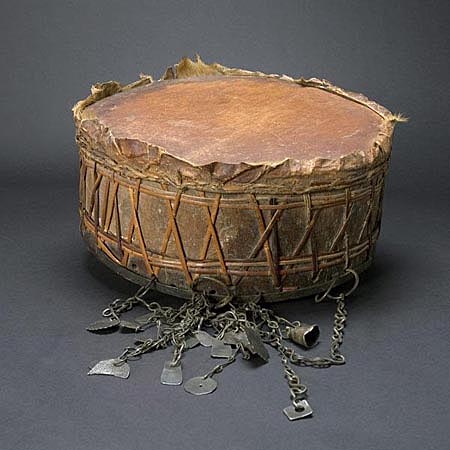
Owner: HWMC
Catalog#: AS-MBST-03-14
Struck Membranophones
Nepal ‘Dhyangro’ (Chepang)
Nepal
Nepalese – Chepang people
Wood, goat hide, rattan, metal
Early-Mid 20th century
Diameter: 18.5 in
Membranophones – Struck Membranophones
This Nepalese dhyangro is a shaman’s drum from the Chepang people. The Chepang, also known as Chewang, is a Tibeto-Burman ethnic group from one of the most isolated regions of the rugged ridges of the Mahabharat mountain range of Nepal. It is considered a sacred instrument, used by the shaman (pande) to make communication with the supernatural forces. This dhyangro is a single-headed frame drum, with a cross-shaped handle inside the frame for holding. The frame is made of wood from a tree called bunsi in Chepang and the membrane drum head and wrapped sides are made of goat hide that are laced with rattan. There are numerous iron chains with various symbolic metal hangings fixed to the frame by means of iron rings. These are located on the inside of the drum opposite the membrane drum head and usually face the shaman (pande) during seances. They are supposed to protect the shaman (pande) from possible attacks from some of the spirits.
The Chepang drum has numerous functions that include not only serving as a musical instrument to accompany the recitation of mythical songs, but it also serves as a pacemaker of ritual dances, as a vehicle on which the shaman travels through space, as a defensive and assault weapon against negative powers, and as a diagnostic and prognostic instrument.
In Nepal a different shaman drum has the same name; this double-headed frame drum is held by an inserted wooden handle in the shape of a wooden dagger and is played with an S-curved cane.
Resource: Chepang Shaman Drum Nepal (drummuseum.com); ‘Dhyangro,” Mireille Helffer/Gert-Matthias Wegner, Simonne Bailey, ‘The Grove Dictionary of Musical Instruments,’ 2nd ed., Vol 2. Lawrence Libin, Editor in Chief. Oxford University Press.
